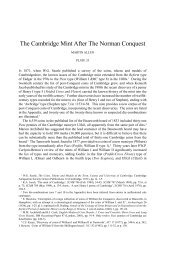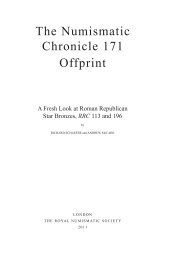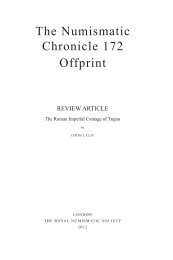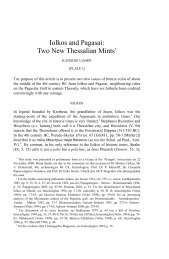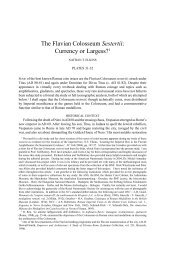The Beginning of Bronze Coinage in Karia and Lykia - Royal ...
The Beginning of Bronze Coinage in Karia and Lykia - Royal ...
The Beginning of Bronze Coinage in Karia and Lykia - Royal ...
You also want an ePaper? Increase the reach of your titles
YUMPU automatically turns print PDFs into web optimized ePapers that Google loves.
8<br />
R.H.J. ASHTON<br />
those <strong>of</strong> the Zeus / pentangle issues which would precede <strong>and</strong> succeed it is troubl<strong>in</strong>g. A s<strong>in</strong>gle<br />
fi rm fi nd-spot would go a long way towards solv<strong>in</strong>g the problem. 30<br />
I should note here another issue <strong>of</strong> fourth century bronzes <strong>of</strong> similarly small module with<br />
on the obverse a female head right <strong>and</strong> on the reverse a spearhead fl anked by the letters Χ −<br />
Α (Pl. 3, 37: 8mm, 0.64g, 03h; my coll., acq. 2002). <strong>The</strong>se have <strong>in</strong> the past been attributed<br />
to Chalketor <strong>in</strong> <strong>in</strong>l<strong>and</strong> <strong>Karia</strong> or Chalke, an isl<strong>and</strong> <strong>of</strong>f Rhodes, but the evidence <strong>of</strong> fi nd-spots<br />
makes it clear that the m<strong>in</strong>t was <strong>in</strong> the Troad or Mysia, most probably the isl<strong>and</strong> <strong>of</strong> Chalkis <strong>in</strong><br />
the Hekatonesoi <strong>in</strong> the gulf <strong>of</strong> Adramytion. 31<br />
Similar is the case <strong>of</strong> some rare fourth century bronzes with types radiate head <strong>of</strong> Helios<br />
right <strong>and</strong> rose fl anked by the letters M-E (Pl. 3, 38: 10mm, 0.78g, 03h; my coll., acq. 1998).<br />
<strong>The</strong>y, <strong>and</strong> the correspond<strong>in</strong>g drachms, are <strong>of</strong>ten attributed to the isl<strong>and</strong> <strong>of</strong> Megiste <strong>of</strong>f <strong>Lykia</strong>,<br />
<strong>and</strong> at all events their Rhodian-like types suggest south-west Asia M<strong>in</strong>or. In fact, however,<br />
recent fi nd-spot evidence makes it quite clear that they come from the Troad; I now believe<br />
that they were struck around 360 by one or other <strong>of</strong> the Rhodian brothers Mentor <strong>and</strong> Memnon<br />
who were mercenary generals for the Persian Great K<strong>in</strong>g, had estates <strong>in</strong> the Troad, <strong>and</strong> at<br />
one po<strong>in</strong>t controlled Lampakos, whose m<strong>in</strong>t produced gold co<strong>in</strong>s with very similar obverse<br />
type. 32<br />
This exhausts the list <strong>of</strong> bronzes from or allegedly from <strong>Karia</strong> which could with vary<strong>in</strong>g<br />
degrees <strong>of</strong> plausibility be assigned to the late fi fth century or fi rst quarter <strong>of</strong> the fourth. <strong>The</strong>y<br />
are all very rare <strong>in</strong> comparison with bronze co<strong>in</strong>ages from later <strong>in</strong> the fourth century, <strong>and</strong> give<br />
the impression <strong>of</strong> rather tentative, experimental co<strong>in</strong>ages which were short-lived <strong>and</strong> had<br />
little economic signifi cance. It should however be noted that several <strong>of</strong> the issues concerned<br />
have come to light only <strong>in</strong> recent years <strong>and</strong> only <strong>in</strong> s<strong>in</strong>gle specimens; future discoveries<br />
may well modify this picture. From the second quarter <strong>of</strong> the fourth century, the practice<br />
<strong>of</strong> m<strong>in</strong>t<strong>in</strong>g bronze spreads to other states. Knidos beg<strong>in</strong>s with an issue <strong>of</strong> chalkoi from<br />
about 375 <strong>and</strong> <strong>of</strong> dichalka a couple <strong>of</strong> decades later; 33 Kos, 34 Myndos, 35 Nisyros, 36 Telos, 37<br />
30 <strong>The</strong>re are no specimens at the museum <strong>of</strong> Fethiye, ancient Telmissos on the coast between <strong>Karia</strong> <strong>and</strong> <strong>Lykia</strong>, but,<br />
given the rarity <strong>of</strong> the issue, this proves noth<strong>in</strong>g.<br />
31 Stauber 1996, Vol. 2 (with M. Barth), pp. 280-2, with preced<strong>in</strong>g bibliography.<br />
32 Ashton 2002b.<br />
33 Pl. 4, 39 (chalkous: 9mm, 1.11g, 02h: BM 1928-7-14-44 (N. Zitelli)); Nordbø 1972, pp. 154-6; Nordbø 1989,<br />
p. 53; Ashton 1999b, pp. 89-92.<br />
34 Ingvaldsen 2002, pp. 164 <strong>and</strong> 167, dates his fi rst bronze issues IX <strong>and</strong> X (e.g., respectively, BMC 99-100 <strong>and</strong><br />
25-6) vaguely to ‘330-250’, but on no very solid grounds; they look more like purely fourth century co<strong>in</strong>ages to me,<br />
though there can be no certa<strong>in</strong>ty. See Pl. 4, 40 (9-10mm, 1.01g, 12h; BMC 25).<br />
35 Pl. 4, 41 (11mm, 1.26g, 12h; my coll., acq. 1972). Louis Robert’s <strong>in</strong>st<strong>in</strong>ct to attribute to Myndos these common<br />
bronzes with Poseidon / dolph<strong>in</strong> + trident + ΜΥ (<strong>in</strong> Akarca 1959, pp. 60-2) has been confi rmed by fi nds <strong>in</strong> the area<br />
(<strong>in</strong>formation from Koray Konuk); see also Ashton 1999a, p. 15, C. Akarca’s date for this issue (c.210-30 BC) is<br />
clearly too late.<br />
36 Pl. 4, 42 (10-12mm, 1.04g, 12h; my coll., acq. 1997); Ashton 1999a. <strong>The</strong> apparent dichalka <strong>of</strong> issue 1 (ibid. p.<br />
17: radiate head <strong>of</strong> Helios three-quarter fac<strong>in</strong>g r. / female head r., with rose beh<strong>in</strong>d, <strong>of</strong>fi cial’s name below, <strong>and</strong> Ν <strong>in</strong><br />
front) are not certa<strong>in</strong>ly attributable to Nisyros. <strong>The</strong>ir heads <strong>of</strong> Helios, with the tie <strong>of</strong> a chlamys below the neck on<br />
some dies, are not dissimilar from those on the ΚΡΑΝ bronzes <strong>and</strong> the early Helios / sph<strong>in</strong>x bronzes <strong>of</strong> Kaunos (see<br />
above), both <strong>of</strong> which can be assigned to the earlier part <strong>of</strong> the fourth century. However, the heads <strong>of</strong> Rhodos on the<br />
probable Nisyrian co<strong>in</strong>s look later. If these apparent dichalka belong to the early part <strong>of</strong> the fourth century, they will<br />
be the only <strong>Karia</strong>n bronzes <strong>of</strong> larger than chalkous denom<strong>in</strong>ation known for that period.<br />
37 Pl. 4, 43 (10mm, 1.53g; Aufhäuser 13 (1997), 192); Robert 1934, esp. p. 46; Ashton 1999a, p. 23; Ashton 1999b,<br />
pp. 79, n. 13, <strong>and</strong> 91, n. 31.



